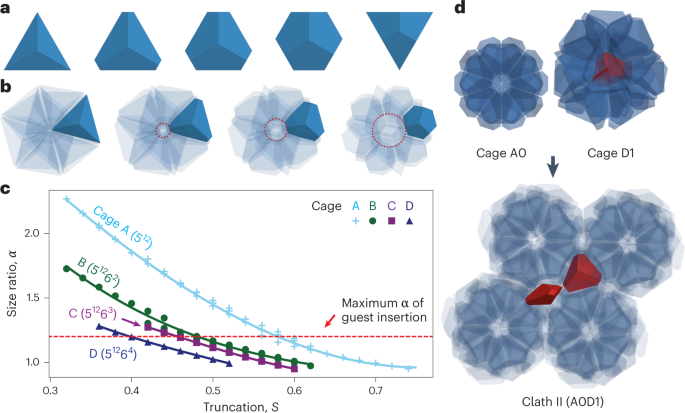2023-05-25 ミシガン大学
◆この発見は、自然な結晶では実現できない光を操作するフォトニック材料の新たな可能性を開くだけでなく、研究チームが「エントロピー区画化」と呼んでいる異例の効果も示しています。エントロピーは通常、系内の無秩序さとして説明されますが、より正確には系が可能な状態を最大化しようとする傾向を反映しています。
◆この研究では、ナノ粒子のケージ構造が他の物質を収める隙間を持つことを示し、構造の特性を変える新たな可能性を提供することが目指されました。
<関連情報>
- https://news.umich.edu/making-the-structure-of-fire-ice-with-nanoparticles/
- https://www.nature.com/articles/s41557-023-01200-6
ホストとゲストが共存するコロイドクラスレートがエントロピー区画化によって安定化することを発見 Entropy compartmentalization stabilizes open host–guest colloidal clathrates
Sangmin Lee,Thi Vo & Sharon C. Glotzer
Nature Chemistry Published:25 May 2023
DOI:https://doi.org/10.1038/s41557-023-01200-6

Abstract
Clathrates are open crystals in which molecules are arranged in a hierarchy of polyhedral cages that encapsulate guest molecules and ions. As well as holding fundamental interest, molecular clathrates serve practical purposes, such as for gas storage, and their colloidal counterparts also appear promising for host–guest applications. Here using Monte Carlo simulations, we report the entropy-driven self-assembly of hard truncated triangular bipyramids into seven different host–guest colloidal clathrate crystals with unit cells ranging from 84 to 364 particles. The structures consist of cages that are either empty or occupied by guest particles, which can be different from or identical to the host particles. The simulations point to crystallization occurring through the compartmentalization of entropy between low- and high-entropy subsystems for the host and the guest particles, respectively. We use entropic bonding theory to design host–guest colloidal clathrates with explicit interparticle attraction, providing a route to realize such systems in the laboratory.



